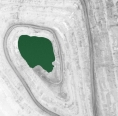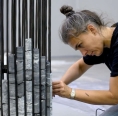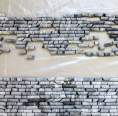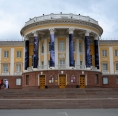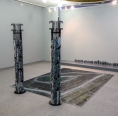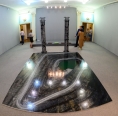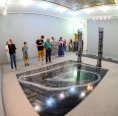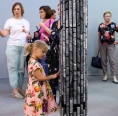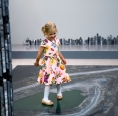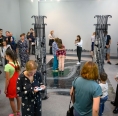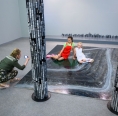-
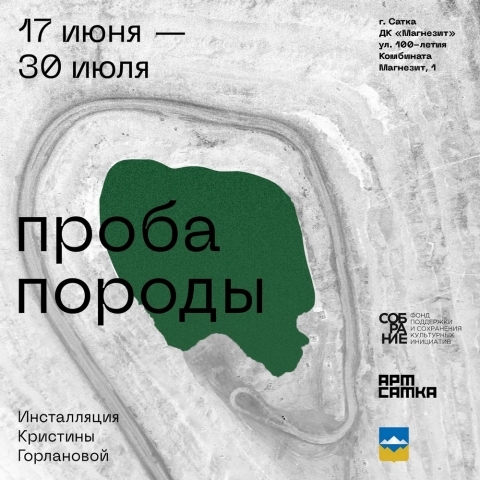
“ROCK SAMPLES”
The site-specific installation “Rock Samples” will open in Magnezit Cultural Center tomorrow, June 17 at 5 p.m. Its author, Kristina Gorlanova, who is an artist, a curator and the head of the Ural Branch of the Pushkin State Museum of Fine Arts, spoke about her project focused on magnesite and dolomite because of their graphic effect. She also mentioned the role of the architecture of the cultural center in the transformation of the original artistic conception, the tests and experiments she made in her studio and the assistants and contributors to the tricky creation and installation of the project brought to life in just two weeks.
Visitors will notice the work of Kristina when approaching the main facade of Magnezit Cultural Center.
“The architectural elements of the building and the interior of the Cultural Center are involved in my work on a par with the minerals, magnesite and dolomite, and the quarry images by demonstrating the interconnection between time periods and emphasizing the specific nature of the place,” noted the artist in the announcement of the exhibition. It was the place chosen for the project which became the inspiring force for the artist.
“Before the interview, I specifically decided to find out when I started to work on this project, it turned out it was four years ago. It all started in July 2017 with a proposal from my colleague Zhenya Chaika (she was planning the “Industrial Promenade” project at that time), she offered artists to choose local materials for the work. The project was moved to September, so I wasn’t able to participate in it, but I saw magnesite and dolomite cores** that summer. This is an incredibly beautiful material of cylindrical shape! Magnesite has an almost floral pattern, dolomite is dark, sometimes with a white pattern. They are both graphical, both monochrome and very beautiful in themselves. In general, I got interested and wanted to come up with something. Given that cores are cool material, I didn’t want to change it much by keeping its recognizable cylindrical shape,” says Kristina. “It took very long to decide what to do with them. When got a box with cores sent from Satka to Yekaterinburg, I started to experiment with them in the studio. I explored how they work together compositionally, how they work with color, with light, how they can be shown in an exhibition and so on.”
It turned out that the original intent of Kristina was to create an abstract sculpture from the cores and use the hall for temporary exhibitions of the Magnezit Museum as an exhibition space. But time passed, the project was delayed for various reasons, and an almost different idea was finally born, a very beautiful, very specific and symbolic one for Satka and Magnezit.
“Abstract sculptures look good, but, I knew I was missing something while working on the first sketch. As a result, I’m satisfied with the way things turned out. Sometimes, apparently, it really needs four years for a project to make out,” says Kristina. “I’m glad that the project I came up with in 2017 didn’t take place. And I’m grateful to my curators and the Sobranie Fund for believing in me, waiting for the result and supporting me all the way. Once I came to Satka again, and we read a lecture on contemporary art with colleagues from the Pushkin State Museum of Fine Arts in Art-Satka. At this point, the coordinator of cultural projects
of the Sobranie Fund Valeriya Tsoi invited me to go to Magnezit Cultural Center and see the exhibition space on the third floor. I had never been inside the center and hadn’t known that about this incredible room now used to demonstrate the results of my project. It is not a perfect exhibition space, it is quite complex but absolutely captivating space. There’s an amazing fresco on the ceiling dedicated to May 1 and it has people looking right at you. I thought, what can be done in this room? It is very specific with its red walls, two scene pieces and this huge fresco! And I started to think about it, what can be put here. And as a result, the building itself, the cylindrical shape of the cores and the chosen approach to work — the sculptural, installational one — led me to a new idea. Firstly, it is related to the fact that the facade of the center has its magnificent columns looking exactly like the cores. And I thought: when covered with a printed cloth, they turn into huge cores and refer to classic marble columns! Secondly, I realized that this idea inspired by the building tips should be continued in the installation.”
Finally, the idea of Kristina turned into a whole narrative starting from the facade of Magnezit Cultural Center with its culmination unfolding in the exhibition hall. Visitors will see a “portal” of two columns of 2,3 meters made in the Roman style with thin metal rods and core pieces. On the one hand, they fit into the symmetry defined by the pilasters adorning the hall, and on the other, they will become the gates inviting to another dimension.
“The metal columns are designed to hold cores pieces,” explains the artist. “First, I wanted to trim them to make smooth edges but then decided to leave natural cracks and different shapes of cores to make the columns look not that monolithic and thick, to let the light get in the structure but not to make them too airy. This will give a ruined effect which accentuates the core pieces standing at the foot of the columns as if scattered from the grid. This is a story telling that a core is a small ruined piece: it has served its time, shown its pattern, underwent laboratory tests, and that’s it, it’s not used for anything further. They collect them at Magnezit specially for artists. The installation is continued with a huge picture of the quarry on which viewers will be able to walk — that’s how they get into another space, another dimension. They will found themselves in between different times: the fresco heroes will be watching from the top and from the Soviet times while there will be the unfolding quarry landscape under their feet. It will be an interesting point!”
If you want to experience this feeling and talk with the author of the project, join the grand opening of the exhibition tomorrow at 5 p.m. The exhibition “Rock Samples” will run until July 30. Admission is free.
“This project has become true with the help of a huge number of wonderful people. Many helped me in addition to the experts of the Magnezit Group and the Sobranie Fund, in addition to the team of Art-Satka, who gave me a place to live for all two weeks and an opportunity to work from morning till night on weekdays and weekends. The workers of Magnezitovaya mine collected the cores. The technicians and the director of the Cultural Center Nikita Savrulin helped me at all stages of the project. The metal columns were produced by the mechanical repair company, whose employees will give beat many businesses in Russia in producing art objects. Alexandr Kharitonov from Our Town helped to cut the core pieces for the ruins and Ksenia Fomina from Satka Polytechnic College covered them with lacquer. By the way, we asked the college workshops to lend their vice clamp. These were the most difficult and the most incredible days when the artistic idea was incarnated in a physical reality. I’m forever grateful to all those with whom I met in this project, to all those who helped to make it out!”
FOR REFERENCE:
Kristina Gorlanova is an artist and a curator, a graduate of the University of the Arts London. She lives and works in Yekaterinburg.
Kristina participated in exhibition projects such as “The Life of Others” (Museum of Soviet Naive, Perm, 2014), “The Frontline of a Frontliner. At the Construction Site of the New Life of the Urals” (Yekaterinburg Museum of Fine Arts, 2016), “Taming the Void. 50 Years of Contemporary Art of the Urals” (National Center for Contemporary Art, Moscow, 2017) and “All is Not What It Seems” (Slovtsov Museum Complex, Tyumen, 2019), Triennal of Russian Contemporary Art (Garage Museum of Contemporary Art, Moscow, 2020).
* Site-specific art means artistic practices inspired by a particular site, its architecture, design, history and/or current functions.
** Core is a sample of rock extracted from a well by a special type of drilling. It is often a cylindrical section (column) of rock.
Photo by Vasily Maksimov.
-
26.08 - 26.08
DIARY OF THE THIRD INDUSTRIAL BIENNALE
-
28.11 - 28.11
MY SATKA FESTIVAL WINS THE CONTEST OF CORPORATE VOLUNTEER PROJECTS
-
13.10 - 15.10
COOPERATION WITH VGIBL NAMED AFTER M.I. RUDOMINO

